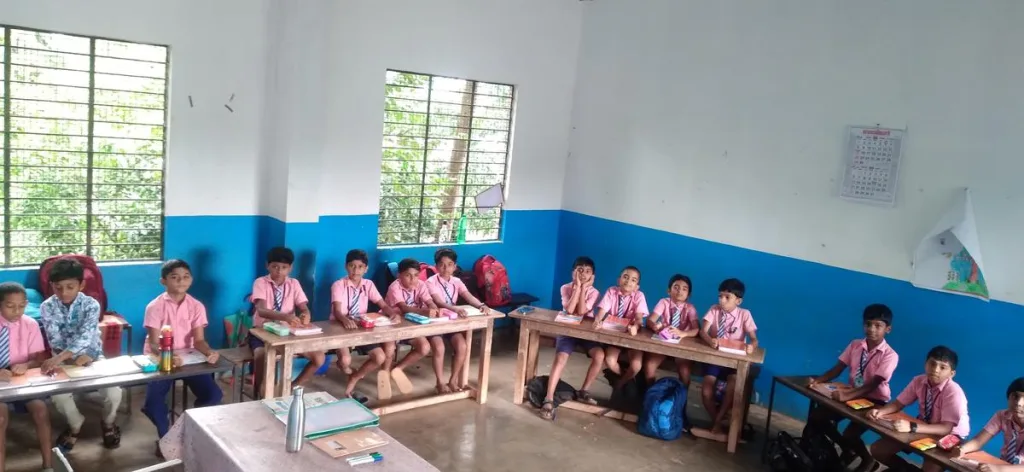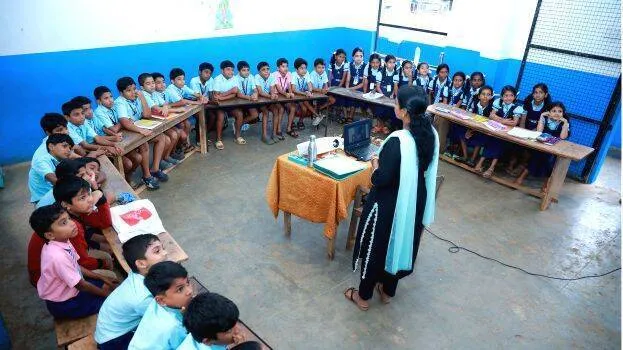Kerala is making headlines with an innovative classroom revolution that’s changing how students learn and teachers teach. A new classroom seating method where students sit in a semicircle is gaining popularity in the state, with no front or back benches, ensuring that every child is within the teacher’s line of sight. This groundbreaking approach is eliminating the age-old concept of “backbenchers” and creating more inclusive learning environments.
Table of Contents
From Bollywood to Reality: The Film Connection
The inspiration for this educational transformation comes from an unexpected source—cinema. The concept gained attention after being featured in the Malayalam film Sthaanarthi Sreekuttan, which was released last year. What started as a fictional portrayal has now become a real-world solution, proving how art can inspire meaningful social change.

The Science Behind Semicircle Seating
In this structure, students are placed in a semicircle where the teacher can observe every student without any obstructions. This configuration removes the chance of students sitting behind and being cut off from the rest of the class. The arrangement creates an environment where every student feels equally important and engaged.
Benefits of the New Arrangement
Academic Advantages:
- Enhanced teacher-student interaction
- Improved classroom participation
- Better note-taking and listening experience
- Equal attention for all students
- Reduced distractions and misbehavior
Psychological Benefits:
- Elimination of “backbencher” stigma
- Boosted self-esteem and confidence
- Increased sense of belonging
- Better peer-to-peer interaction
Implementation Across Kerala Schools
| School Details | Information |
|---|---|
| Pioneer School | RCC LP School, Wadakkanchery East Mangad |
| Classes Covered | LKG to Class 5 (7 divisions) |
| Student Strength | 20-30 students per class |
| Other Schools | RVV Higher Secondary School in Kollam and several others in Kannur and Thrissur districts |
| Arrangement Type | U-shaped/Semicircle seating |
| Implementation | Flexible seating arrangements where students rotate their seats periodically |
Student and Teacher Testimonials
The real proof of this innovation’s success comes from those experiencing it firsthand. V.J. Angel, a Class 5 student at RCC LP School, shares: “It’s easier to study with benches arranged like this. We can hear what the teacher is saying and take notes better.”
The positive impact is equally evident from the teaching perspective. Liji, Head Teacher, reports: “We implemented this seating last month. It has already brought noticeable improvement in the students’ academic performance.”

Official Recognition and Support
The educational reform has garnered attention from high-profile officials. Kerala General Education Director S. Shanavas said that a decision on implementing the method more widely will be taken after studying factors such as classroom size and student strength.
Former DGP Rishiraj Singh praised the idea on social media, calling it revolutionary. He noted that this method could help eliminate the negative labelling of students as “backbenchers,” which often affects their academic performance and self-esteem.
Historical Context and Revival
Originally suggested under the District Primary Education Programme (1994), it is now revived through public influence. This shows how good educational ideas can find their time and place, even decades later.
Breaking Educational Hierarchies
Instead of the traditional rows which separate students into “frontbenchers” and “backbenchers,” many schools are going for a U-shape. There, every student can be seen by the teacher, who positions himself at the centre of the open arc. This physical restructuring represents a deeper philosophical shift toward educational equality.
The Broader Impact
A semicircular layout places students in an arc, facing the teacher at the center. It breaks the front-bencher vs back-bencher division, fostering equal participation. This innovation addresses fundamental issues in traditional classroom dynamics that have persisted for generations.
Looking Forward
As Kerala continues to pilot this revolutionary approach, other Indian states are watching closely. The success of this model could inspire nationwide educational reforms that prioritize student equality and engagement over traditional hierarchical seating arrangements.
The transformation from traditional rows to semicircular arrangements represents more than just a physical change—it’s a paradigm shift toward inclusive education that recognizes every student’s potential, regardless of where they sit.
Related Articles:
Official Sources:
Frequently Asked Questions
Q: Which schools in Kerala have implemented the semicircle seating arrangement?
A: The RCC LP School in Wadakkanchery East Mangad was the pioneer, implementing this arrangement across all seven divisions from LKG to Class 5. Other schools that have adopted this model include RVV Higher Secondary School in Kollam and several schools in Kannur and Thrissur districts, with each class accommodating 20-30 students in the U-shaped arrangement.
Q: What inspired Kerala schools to adopt this new seating arrangement?
A: The concept gained attention after being featured in the Malayalam film “Sthaanarthi Sreekuttan” released last year. However, the idea was originally suggested under the District Primary Education Programme in 1994 and is now being revived through public influence, showing how cinema can inspire real-world educational reforms.








